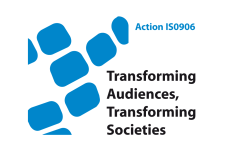- About the Action
- Events
- PhD workshop - Ljubljana 2014
- Action Open Conference - Ljubljana 2014
- New Media and Participation conference - Istanbul 2013
- Belgrade meeting 2013
- Media literacy research and policy - Brussels 2013
- ICA Pre-Conference 2013
- Tampere meeting 2013
- Budapest workshop 2012
- Milan meeting 2012
- Brussels PhD workshop 2012
- Brussels Action workshop 2012
- London meeting 2011
- Zagreb Conference 2011
- Lisbon meeting 2010
- Affiliated events
- WG 1
- WG 2
- WG 3
- WG 4
- Cross-WG
- Output
The challenges of interactivity for audience research
Kleut, J., Milojević, A., Ninković, D. (2011). The challenges of interactivity for audience research . Zagreb conference: "New challenges and methodological innovations in European media audience research". 7-9 April 2011.
Abstract: This paper examines how existing and emerging audience research methodologies respond to different types and levels of audience/users interactivity, especially the ones afforded by new media. It is based on a presumption that the rise of interactivity is not a disruption in the history of audiencehood, but rather a developing trend that can be traced back from the practices of usage of “the old media”. Still, the intensity by which interactivity becomes the defining feature of new media requires us to review it on its own. Following Fornas et al. (2002) and McMillan (2002), this often contested concept in media studies can be disambiguated by subdividing interactivity into social interactivity (i.e. human-to-human interactivity), textual interactivity (i.e. human-to-text interactivity) and technical interactivity (i.e. human-to- medium/system interactivity). In this paper, the classification is further developed by adding the category of levels of interactivity (low, medium and high) which allows further elaboration of different mediated practices. This leads to specification of nine theoretical subsets of interactivity. The main hypothesis of this paper is that each interactivity subset, defined by type and level of interactivity, opens different methodological questions – about units of analysis, data gathering, data processing, etc. The aim of this paper is to map out the relevance of existing and emerging research from the perspective of interactivity, as well as to point out the shortcomings and under-researched areas of interactivity by reviewing well established methodologies and recent novelties presented in international journals.

